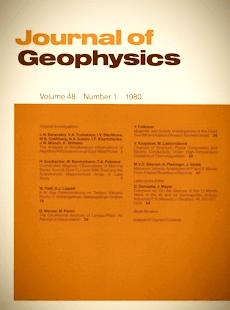Teleseismic evidence for velocity heterogeneity beneath the Rhenish Massif
Article Sidebar

Vols. 1-18 (1924-1944), ISSN 0044-2801
Main Article Content
Abstract
Observations of teleseismic P wave residuals for 56 stations in the vicinity of the Rhenish Massif show that arrivals within the Massif may be up to 0.6 s later than those immediately outside. Stations within the Massif also tend to have delays which are strongly azimuthally dependent (up to 1 s variation) in marked contrast to those outside (maximum 0.3 s variation). The strongest variation and delays are associated with the area of the Massif west of the Rhine, and preliminary modelling suggests they are caused by a low velocity region in the uppermost mantle (ca. 50–150 km depth) centred beneath the West Eifel volcanic field. Delays of up to 0.8 s, but with little azimuthal variation, are also found within the Vogelsberg volcanics, and are attributed to a shallower (≲60 km) low velocity region.
 ARK: https://n2t.net/ark:/88439/y073559
ARK: https://n2t.net/ark:/88439/y073559
Permalink: https://geophysicsjournal.com/article/187
Article Details
References
Engdahl, E.R., Sinndorf, J.G., Eppley, R.A. (1977) Interpretation of relative teleseismic P wave residuals. J. Geophys. Res. 82:5671-5682
Panza, G.F., Mueller, St., Calcagnile, G. (1979) The gross features of the lithosphere-asthenosphere system in the European Mediterranean area. Phys. Earth Planet. Inter. (In press)
Raikes, S.A. (1976) The azimuthal variation of teleseismic P-wave residuals in Southern California. Earth Planet. Sci. Lett. 29:367-372
Wenderoth, R. (1978) Laufzeitanomalien teleseismischer P Wellen im Gebiet des Oberrheingrabens. Diplomarbeit, Geophys. Institut
Universitlit Karlsruhe, p. 170











